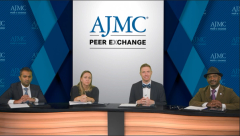
Updates in NCCN Guidelines of Frontline Treatment for MM
Highlighted are updates in NCCN guidelines for frontline MM treatment strategies.
Episodes in this series

Ryan Haumschild, PharmD, MS, MBA: Let’s talk about a case study in multiple myeloma and some notable updates to guidelines in the front line based on the NCCN [National Comprehensive Cancer Network]. Are there any new updates that you think are notable, Dr Lipe? [Anything] you think would be good to share with our audience?
Brea Lipe, MD: The advantage of NCCN is that it’s so broad, it allows us a justification mechanism for getting most of what we want, and it’s updated regularly so we can do that. I looked the other day, and there are 14 regimens recommended for the up-front therapy in transplant-eligible myeloma and 12 in the transplant-ineligible population. That’s a staggering number. Trying to make sense of that can be extremely difficult. But I like the guidelines because they allow me to fit the patient in front of me. I know that the adverse effects of this regimen vs that regimen. I know who the patient is in front of me. That’s what builds the eloquence in this disease and the capacity to tailor what we do. When you have such a breadth of options for the treatment that are recommended, we can tailor our therapies.
One notable change is that daratumumab has been incorporated into the frontline setting. Based on the GRIFFIN data, they include another preferred regimen for certain circumstances: RVd [lenalidomide, bortezomib, dexamethasone], which is 1 of the new ones. Ixasomib is an oral proteasome inhibitor that’s also included as an option in an up-front therapy. These new drugs get incorporated as they’re studied in the frontline setting. Over time, that will continue to change. We’re incorporating some of our newest therapies and approvals into the frontline setting. That’s going to continue to evolve, which increases the playbook for what we can do for patients. That’s what we need and what our patients need.
Ryan Haumschild, PharmD, MS, MBA: I like that. You said it increases the playbook because it gives patients options. If an organization wants to make it more streamlined, they have the option to do so. But at least you know which regimens are recommended. That’s always a great thing.
Brea Lipe, MD: One thing I forgot to mention is that it makes it easier to get it paid for. When there are 1 of 14 regimens in there, I can justify that to an insurance company because NCCN says it’s good. That’s another benefit to the NCCN: reimbursement.
Ryan Haumschild, PharmD, MS, MBA: That’s great. Part of our AJMC® audience is the managed care group. A lot of medical directors look at these to understand what the leading regimen should be and what should be approved based on the latest data. As you said, when leading practitioners look to NCCN and want to utilize these regimens, and we get payer approval, it’s good for the patient because it’s evidence based and consortium recommended, and so leading practitioners recommend it. Therefore, we get timely access for our patients, which can drive great outcomes.
Dr Nadeem, we’re talking about working with internal pathways. Can you talk to us about how they are in accordance with NCCN? Do they differ at all? Do you adopt data earlier than NCCN? Please help us understand, is it more of the foundation of NCCN, and do you build upon it? It’s helpful for viewers.
Omar Nadeem, MD: As Dr Lipe mentioned, the NCCN Guidelines are great because everything is in there. Because myeloma data are so vast, and there are so many trials, they’re hard to organize. The NCCN Guidelines are great for having the studied regimens in there. But it’s our job, in our internal pathways, to give guidance and make a pathway out of that. The overlap is there, but if you break it down—what line of therapy patients are in, whether they’re lenalidomide refractory—[the guidelines have] different regimens. They give you a little more guidance. For somebody coming off lenalidomide, what are the options you want to think about? That’s all in the NCCN Guidelines. It overlaps a lot. The field is moving together because we have regular review meetings, so we don’t feel as if we’re lagging from the other guidelines or recommendations out there. [NCCN] fine-tunes that mechanism to give providers a little more guidance.
Ryan Haumschild, PharmD, MS, MBA: That’s great. It aligns with the guidelines, and you know you’ll get paid because it’s in the NCCN Guidelines. There are always those positives, [so it’s good to] be in line with those.
Transcript edited for clarity.
Newsletter
Stay ahead of policy, cost, and value—subscribe to AJMC for expert insights at the intersection of clinical care and health economics.








